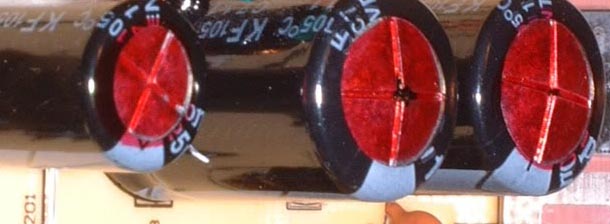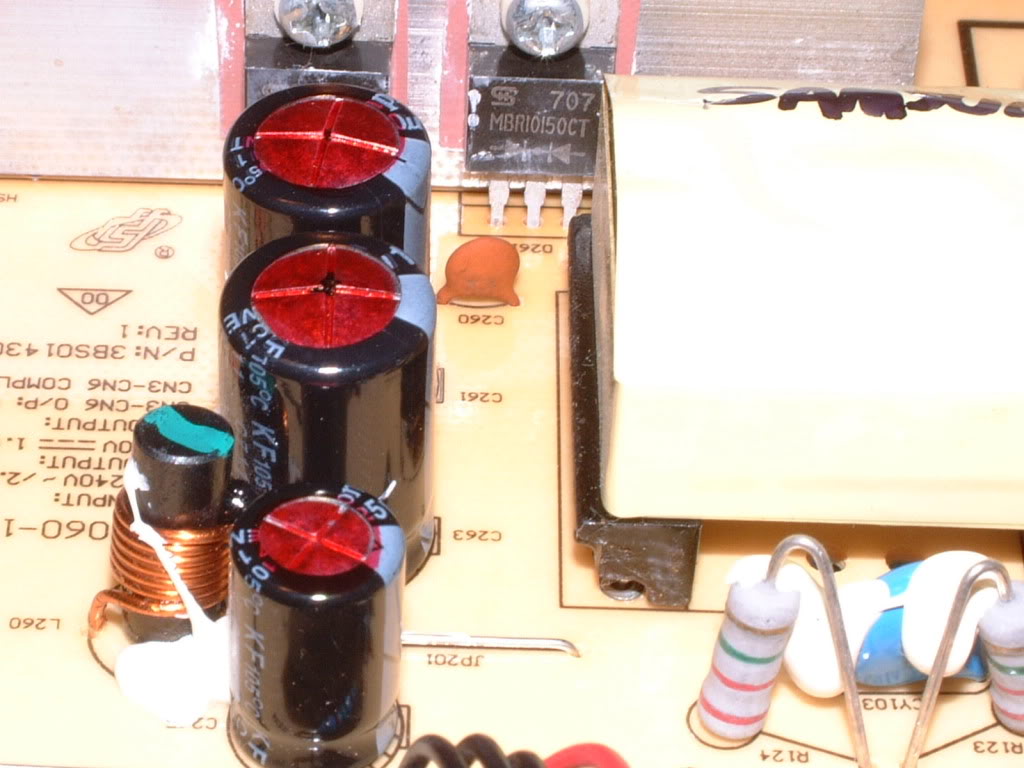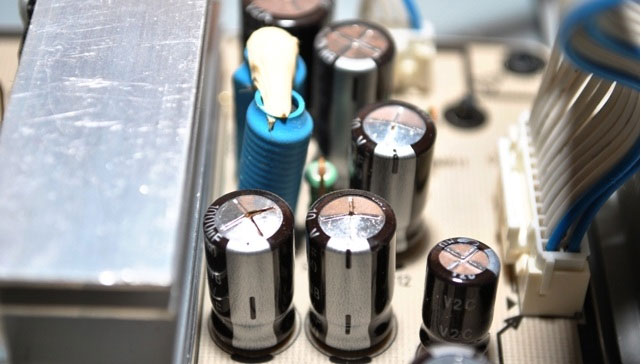Capacitor issues galore.
This weekend I serviced one more Samsung 205BW monitor dealing with a very infamous capacitor issue. One which has caused some attention and lawsuits similar to dell and other companies dealing with. A crappy Chinese capacitor company "CapXon" handing out a bunch of mid-range low-temperature caps inside of a confined space where there can be up to 4 or more high voltage back-lights going resulting in the insides of your monitor cooking and respectfully your capacitors overheating as well.
I guess I am just posting this because I don't want to see LCD monitors go needlessly into a landfill all because of a stupid part that costs a few dollars at the very most for capacitors! And someone with mediocre soldering skill. (Ladies and Gentlemen, please don't use solder braid on a power board, you'll destroy the traces. Get a solder sucker. A good quality one!)
Picture showing what a blown capacitor looks like on a default Samsung power board. You'll note the two in the middle (typically 820uf 25v capacitors) are the ones that are bulging or popped, leaking corrosive material all over the cap or board giving that 'rusted out' look to it all.
Capacitor substitution.
A month prior I service 3 more Samsung monitors this very way. And I will say that in a default capacitor variety pack an 820uf capacitor is not all that common, especially at 25v) So what does any good tech do? They substitute.
Original Samsung LCD capacitor configuration running parallel on the power board traces:
2x 820uf 25v capacitors
My Substituted configuration for the Samsung displays:
1x 1000uf 25v capacitor
1x 680uf 25v capacitor
NOTE: The Samsung board also had 3x 330uf 25v caps which we replaced as well on all of the boards I serviced because I have little to no respect to CapXon.
I did the substitution because I don't have 820uf caps. Since both caps are on the same trace rail then as long as the total UF of both caps is within +/- %10 error then the replacement will be fine 2*820uf=1640uf - 1000uf+680uf=1680uf - In a power board environment it is considered acceptable and thus the replacements on all four monitors have been working flawlessly since the repair.
Now it's disclaimer time.
Disclaimer: You should never substitute for other types of capacitors unless your absolutely sure that you know what you're doing. Always check your power against an oscilloscope to ensure the ESR is within tolerance to drive your device prior to hooking everything back up. I need to put this warning in here because if I don't I will probably enrage some electronics people.
Picture above - 32" Samsung flat panel television with multiple bad 1000uf 25v and 35 volt capacitors.
I have also taken the liberty of fixing a few of the larger screen televisions that were at a friend's Italian Restaurant. The picture above is the approximate representation of that power board. but it appears that Samsung has had a really long track record of capacitors exploding. on the 32" that we worked on, we replaced
- 1 - 2200uf 10volt capacitor
- 4 - 1000uf 35volt capacitor
- 2 - 1000uf 25volt capacitor
- 1 - 3300uf-10volt capacitor
After replacing all of them the flashing red light remained solid which ended up saving a football night at her restaurant. We are glad Samsung used a more standard capacitor for their higher-end displays. Yes, they were still under warranty but Samsung wanted to exchange them which would take days to accomplish. Days of no TV mean thousands of business dollars lost to this restaurant so in their mind voiding the warranty was well worth it. And if it meant paying for $10 worth of caps and an hour of my time. Versus hundreds of dollars. Even better!
A side-note we have been also fixing dells and Acers which experience similar problems. Mostly CapXons however there were a few power boards that were refurbished the had swollen caps and they were Rubicons. Which goes to show that you can even destroy the good quality caps in these things because of their amazingly poor ventilation.
Getting capacitors is easy, you can go through mouser, or digikey, or even Ebay so long as you watch what you are buying (try not to get caps from china that do not have a brand-name behind them as they -could- be the crap tin-and-paper caps) .
What about polymer capacitors for use on power boards?
After looking through a lot of forums about this I've come to the conclusion that this is a bad idea. Liquid Capacitor to Polymer substitution even on a motherboard is highly experimental. To do so on a power board is to do so at your own risk! The main reason why you don't see polymer capacitors for power boards is the voltages are much higher than being on a motherboard and it's hard to find polymers above 16+ volts.
Your best bet is to get some name brand liquid capacitors that have a low ESR value and can withstand higher temperatures (above 105+C) to ensure a long life with your monitor.
Final thoughts.
Apparently the proper term I should have used for this article should have been "Capacitor Plague" as pointed out by the Wiki. However, capacitor failure continues to happen to this day and I am going to have to disagree with Wiki that this plague really ended. In some cases, it's because a company wanted to pump out a product as cheaply as possible so they take a chance on one of these newer capacitor manufacturers which have no prior history. Other times it's because of piss poor engineering where they seal their monitor up so tight that there's practically no room for the heat to escape. Heat can destroy even the best of caps as we've pointed out earlier in this article. Just know that sometimes the quality of the capacitor doesn't matter if the environment it's housed in is poorly thought out.
We hope this helps you out a little.




What brands of capacitors do you trust?
Digi-Key sells Nichion Capacitors which we consider an 'Okay' capacitor. Whenever possible we will go out of our way and order Rubycons as they seem to endure the torture of an enclosed environment. In the Samsungs we've repaired we replaced them all with Rubycon and those lasted for 3-4 years before the restaurant gave those away for family members to purchase bigger screens.
You are so right. CapXon crapacitors belong in a landfill, immediately after manufacture, and shame on Samsung and all manufacturers for using them. Personally, I've replaced dozens in failed electronic equipment. It can truly be said, "I've flushed better things down the toilet". In Canada, Digikey is our best source for quality electronic components.
My 12 yr old Samsung 21" computer monitor has stopped working, inside are 3 bulging CapXon caps, 2x 1000uF 25v and a 750uF 25v. Thanks for the neat website! The solidarity is disconcerting!
Sounds like you got a good run on that monitor. With a few bucks on Rubycon caps you'll probably get many more years. Thanks for checking out my blog!
Tom I use a Hakko de-soldering gun. It get hot and vacuum pump sucks the hot solder off the board. Variable heat and tips. A little pricey but if you do a lot of soldering it's worth the investment.
Best of luck,
Mason
Found Cap Xon Electrolytic capacitors in my Extron switch mode power supplies. I have replaced close to 100 of these in the school district over the last few years. These power supplies aren't cheap even though they are more junk out of China. Wish they would use decent parts. The Extron Power supplies are proprietary so Extron won't give me a schematic or parts list. I can't tell you how much I appreciate all their help.
Mason
Wow, glad it helped you out! Although it's an older article I've been finding out a third reason they go which is simply age. The electrolytic fluid dries up after 8-10 years. Recovered a few Commodore Amiga power supplies which would've costed hundreds to find replacements.
Anyhow, Thanks for checking out my blog!